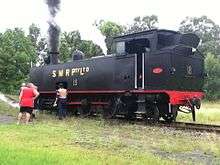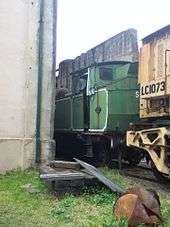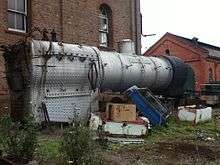Hunter Valley Mining Locomotives
Hunter Valley Mining Locomotives (Australia) included the South Maitland Railways 10 Class which were ordered by SMR and built by Beyer Peacock. Beyer Peacock suggested a tank engine as it would be ready earlier and could go fast backwards as opposed to a tender engine which could not. They arrived between 1912 and 1925 with a total of 14 engines produced. These served alongside Richmond Vale Railway's ROD 2-8-0s and Kitsons, and New South Wales Government Railways locomotives. Also made by Beyer Peacock was the SMR 15 class which was a copy of the NSWGR 30 Class. Numbers 15 and 16 were built in 1912 and No 29 in 1923. These were initially used for passenger services but when that stopped they pulled coal for the rest of their lives. All were scrapped in late 1973. The Kitson locomotives were known on the Richmond Vale Railway as the 9-11 Class. Locomotives 9,10 and 11 were tank locomotives and had the appearance of a side tank version of an ROD 2-8-0. Numbers 9 and 10 ended their careers on the RVR's Hexham washery shunt and the short trip to Stockrington Colliery. No 9 was originally called Pelaw Main and 10 was called Richmond Main. No 11 was called Hexham. The ROD (British Railway Operating Division) 2-8-0 Locomotives mentioned above were purchased by J&A Brown for Coal Haulage on their Richmond Vale Railway, 13 ROD Locomotives were purchased in all, three remain.
Preservation
Kitson 9-11 Class
Number 11 was scrapped but both 9 and 10 are on display in open storage at the Richmond Vale Railway Museum, New South Wales.
Beyer Peacock 10 Class
Hunter Valley Railway Trust
Locomotives 17,20,23,26,27,28 and 31 are at the Hunter Valley Railway Trust at Rothbury, New South Wales. No. 23 was operational but has been dismantled for repairs. No 27 is just bunker and frames after its side tanks and boiler were used to restore No 10. No 17 is in open storage whereas 20,26,28,31 are in covered storage.
East Greta

Locomotives 10 and 18 are currently operational at East Greta where they returned to in November 2010. This was a few years after No. 10's return to steam and No. 18's return from 3801 Ltd for which it worked The Cockatoo Run and where it received an extended smokebox and extended coal bunker. The latter has been removed.
Richmond Vale Railway Museum

Locomotives 22,24,25 and 30 have been at the Richmond Vale Railway Museum since the closure of the Richmond Vale railway line. Locomotives 24 and 25 were restored to steam at the RVRM where they worked until the late 1990s. No 24 and 25 were withdrawn because their boilers must be lifted from the frames and the frames inspected. Locomotive No. 30 was returned to steam in April 2000 and worked until 2009.No 30 was withdrawn because it is in bad mechanical condition. The RVRM's current plan is to put No. 30's boiler into No. 24's frame to accelerate its return it to steam.
Locomotive No. 19 was plinthed near the Port Waratah coal loader, Newcastle from the mid-1980s. It was later removed from its raised plinth and placed in storage at nearby Kooragang Island. In 2009 it was taken to the RVRM where it is now displayed.
ROD Class

A total of 521 ROD locomotives were built and three are preserved, all in New South Wales:
- No 23, withdrawn as No 21 is at Richmond Vale Railway Museum and is in a dismantled state after a stalled restoration attempt.
- Nos 20 and 24 are stored Dorrigo Steam Railway and Museum. Locomotive No 24 is rumored to have a good boiler.
Operation
The South Maitland Railway was the second last privately operated steam locomotive railway in Australia until 1983 when SRA diesel locomotives took over. EL Class diesel locos are the current locos to go from Newcastle Port to Pelton Colliery.
References
www.australiansteam.com